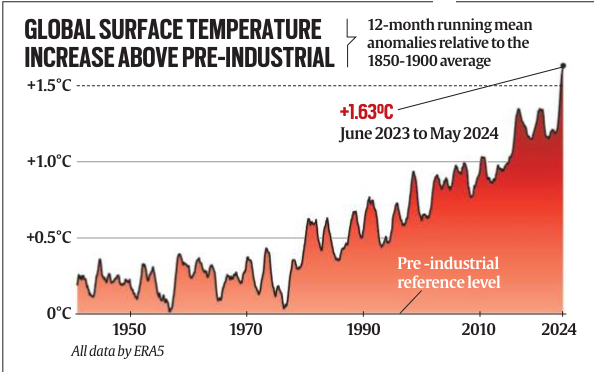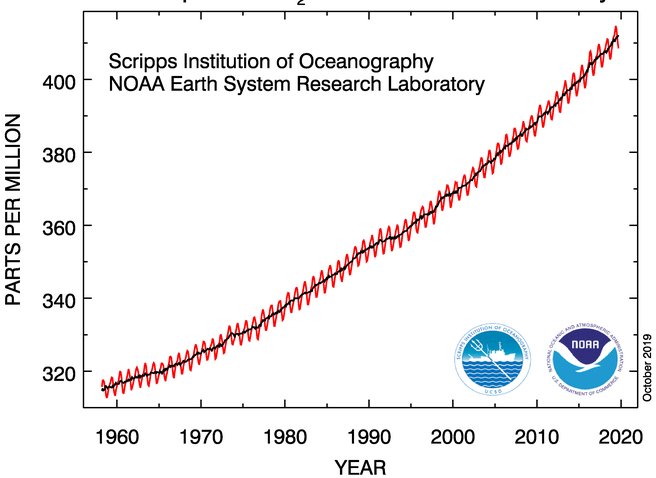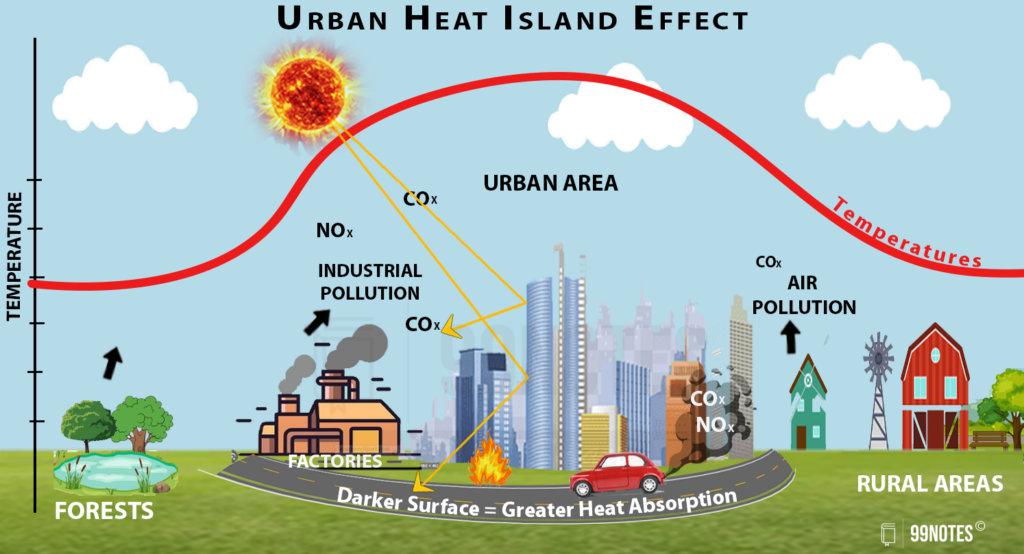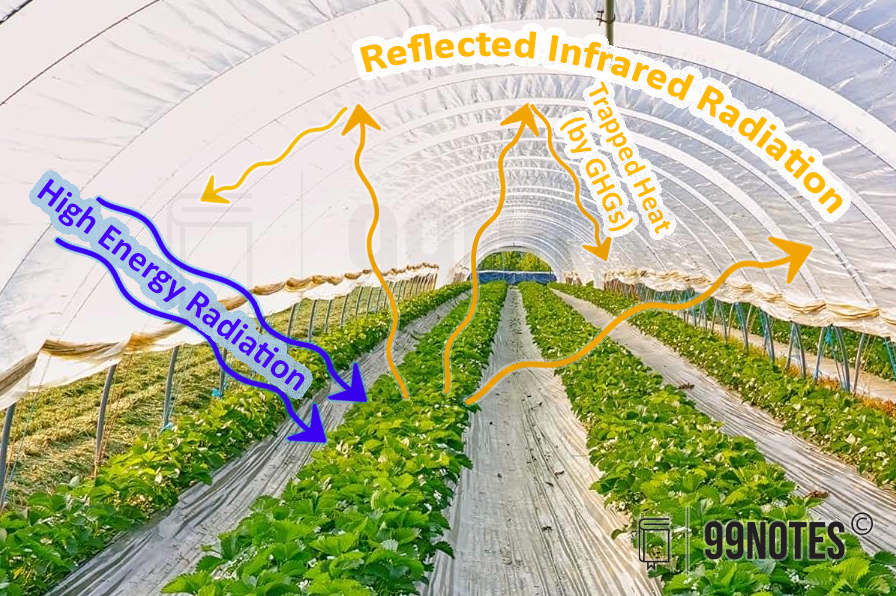Global Warming- UPSC Notes
Global warming refers to the rise in global temperatures since the 1880s (i.e. the preindustrial levels) that has led to changes in the weather patterns around the globe.
In the history of its evolution over a period of 4.5 billion years, the Earth has witnessed several events of climate change, many of which have led to mass extinctions. In recent times, humans have created yet another unprecedented change in the earth’s climate.
|
Anthropocene |
|
The impact of human civilisation on the evolution of Earth has been so severe that an unofficial unit of geologic time has been coined to describe it. It is known as the Anthropocene epoch and it describes the period when human activity began to significantly impact the Earth. It’s not yet officially recognized as a new epoch by some scientific groups. |
Human Impact on Climate
- Human Impact on Climate
- Global Warming
- Climate Change
- Green-house gases:
- Global warming potential (GWP):
- Carbon Dioxide
- Urban Heat island
- Sea Level Rise
- Environmental Impact:
- Impact on Agriculture:
- Economic Impact:
- Social Problems:
- Climate Change Feedback loops
- Environmental Migrants:
- International Conventions on Environmental Migrants:
- Way Forward: Fight Against Climate Change
In recent times, climate change has been primarily driven by human activities, particularly the burning of fossil fuels, deforestation, and industrial processes, which release greenhouse gases like carbon dioxide into the atmosphere, disrupting natural climate patterns. This has caused the sea levels to rise, more frequent extreme weather events, such as heatwaves and storms, shifts in ecosystems, and threats to biodiversity.
In this chapter, we will focus on climate change and its impacts in detail.
Global Warming
Global warming is the long-term warming of the planet, often calculated relative to the pre-industrial level (c. 1850-1900).
The processes that warm the atmosphere are often collectively referred to as the greenhouse effect. In the last 150 years, humans have released large amounts of greenhouse gases into the atmosphere enabling it to trap large amounts of heat, causing a significant rise in the average temperature of the atmosphere.
In this chapter we shall study how the climate has changed over the years, why has it changed and how it impacts our lives and our environment.
| Studying Climate Change |
|
The type of climate we experience now might be prevailing over the last 10,000 years with minor and occasionally wide fluctuations. We get to know about the historic changes in the temperature through various sources:
|
Climate Change

Climate change refers to long-term changes in temperature, precipitation, and other atmospheric conditions on Earth.
The annual average near-surface air temp of the world is around 15oC. This was not always the case. Before the Industrial Revolution (1850-1900) the world average temperature was 13.7oC. The earth has been warming since the pre-industrial level. As shown in the graph.
Global mean temp by the end of the 20th century was recorded as 0.6oC above the pre-industrial level. In fact, 1998 was not only the warmest for the century but for the millennium. Most recent estimates about global warming indicate that global temperatures have risen by more than 1.5oC to the pre-industrial level.
In order to understand why this temperature has risen, we need to first study the greenhouse effect.
| Credit: Indian Express – via Copernicus Climate Change Service |
In order to understand why this temperature has risen, we need to first study greenhouse effect.
Green-house gases:
Sources of GHG emissions:
The Sources of GHGs can be grouped as either natural or Anthropogenic:
- Volcanism is the most natural source of Greenhouse gas emissions. Eruption throws lots of aerosols into the atmosphere – for a considerable period of time reducing the sun’s radiation reaching Earth’s surface.
- Anthropogenic Effect/ Global warming: The current increasing trend in the Concentration of Greenhouse gases is attributed to fossil fuel burning by humans to cover their energy needs. CO2 is the most prominent GHG with the Largest Concentration in the atmosphere. It takes 20-50 years for the atmospheric CO2 to sink back into biomass through photosynthesis.
Some other gases such as nitric oxide (NO) and carbon monoxide (CO) easily react with GHGs and affect their concentration in the atmosphere.
Global warming potential (GWP):
Global warming potential (GWP) is a measure of how much heat a greenhouse gas traps in the atmosphere up to a specific time horizon, relative to CO2. It compares the amount of heat trapped by a certain mass of the gas in question to the amount of heat trapped by a similar mass of carbon dioxide in its lifetime and is expressed as a factor of carbon dioxide (whose GWP is standardized to 1).
| Greenhouse Gas | GWP (in 100 years) |
| CO2 | 1 |
| CH4 | 25 |
| Water vapour | Negligible |
| N2O (Nitrous oxide) | 298 |
| HFCs, | 1000-20000 |
| CFCs, | 100-10000 |
| Carbon Tetrafloride | 50,000 |
The GWP value has a very wide range for different classes of gases. The highest being for the various refrigerant gases used in cooling systems.
The GWP values are also computed for the 20-year lifespan of a gas and for the lifetime.
Carbon dioxide has the biggest impact on global warming compared to any other gas, despite having lower Global warming potential compared to other gases. It is because it is being released in the greatest amount.
Carbon Dioxide

The World’s 82% of energy comes from fossil fuels which are predominantly based on carbon. During the pre-industrial era, CO2 concentration was around 0.027% or 270 ppm (part per million). Presently, Earth’s atmosphere has exceeded 0.040% or 400ppm of CO2 and its concentration is currently rising at the rate of 0.5% annually.
It had been rising at the rate of 4%/year in the 1990s; Currently, it is rising at the rate of 1%/year;
Generally accepted limit: 350-400ppm for a safe climate. The last time it was so high 2Mn years ago, when the sea level was 6m higher than today’s level.
Fluctuations in CO2 concentration: In summer CO2 is found in lower concentrations since the Vegetation in the northern hemisphere absorbs Carbon. In autumn, Carbon rises in the air.
| Image Credit: NOAA |
Effectiveness of GHG depend upon:
- Magnitude of increase in its concentration.
- Its life time in the atmosphere
- Wavelength of radiation it absorbs.
Impact of other GHGs:
- Water vapour is the most potent greenhouse gas other than CO2. It has a low global warming potential (GWP), but its concentration can reach as high as 50,000 ppm or 0.5% in tropical areas, trapping a substantial amount of heat. However, its concentration cannot be controlled in the atmosphere.
- CH4: Naturally when vegetation is digested or rotted in the absence of Oxygen, Methane is emitted. A large amount of Methane is produced from paddy fields, coal mines, rotting garbage dumps and fossil fuels.
- N2O: Nitrous Oxide occurs naturally in the environment. Its quantities have increased significantly due to its use in chemical fertilizers and the burning of fossil fuels. It traps heat 300 times more than CO2.
- CFCs and HFCs: It is an Industrial pollutants with very high GWP Used in air conditioning etc. In the stratosphere, it damages the Ozone layer, and in the Troposphere, it traps large amounts of heat. Therefore, even small leaks in the AC piping in urban areas can create an “urban heat island”.
Urban Heat island
We have already seen that the global average temperature has risen by around 1.65oC above the pre-industrial level. However, it has been seen in the recent times that urban areas have been experiencing severe heat wave more frequently than the rural areas.
In general, the urban landscape is hotter than the rural landscape. This phenomenon is known as the Urban Heat Island Effect.
This happens due to 3 reasons:
- Greater Heat absorption: The surface is darker in the urban region which absorbs more heat. Further, the reflective design of buildings channelizes the sun rays towards the darker regions.
- Greater concentration of Greenhouse gases: Due to vehicular pollution, industrial pollution, burning of fuel and leakage of greenhouse gases, the urban environment traps more heat.
- Greater generation of heat: Due to higher rates of consumption of electricity, and cooling systems pumping out heat into the environment, the urban areas produce more heat. This again gets trapped by the greenhouse gases.
In summary, greater production and absorption of heat creates a local heat island.

Adverse effect due to global warming:
We are now witnessing an increasing frequency of severe droughts, some of which last for decades. For example, in the Sahel region – South of the Sahara Desert, a drought lasted for 10 years between 1967 and 1977.
The adverse effects of Climate change can be summarised as the following:
Disasters:
- Increased intensity of disasters: Cyclones will be accompanied by severe and more frequent storm surges, heavy rain and flooding. Extreme wet and dry seasons would be the new norm.
- Heat waves: With more frequent hot days and intense heat waves, the IPCC’s AR6 report says that heat-related deaths will increase in Asia with changing climate. The same has been observed each year in summer in India.
- Greater variation in rainfall: creating extreme cyclonic activities, floods and drought.
Sea Level Rise
Rise in the sea level due to the melting of glaciers and ice-caps and thermal expansion of the sea may inundate large parts of the coastal area and islands.
- Thermal Expansion is responsible for approximately half of the observed sea level rise. As ocean water warms, it expands. This process has contributed to around 3–0.4 mm/year of sea level rise over recent decades. Given current global warming trends, thermal expansion is expected to remain a major contributor.
- Melting of Glaciers and Ice Caps: It contributes significantly but less than thermal expansion. Melting glaciers and ice caps account for roughly 1/3rd of the sea level rise. This has led to an additional rise of about 2–0.3 mm/year. The accelerated melting of ice in polar regions is expected to increase this contribution over time.
- The loss of the Polar Ice Sheet is another big reason for the sea level rise. However, as we know floating ice does not raise the water level upon melting. Therefore this process has caused about 2 mm/year of sea level rise. But it is expected to accelerate with continued warming.
Impact of Sea Leve Rise
- Inundation of Coastal areas, including low-lying islands, may become submerged, resulting in the loss of land and habitat.
- Non-livable Cities: Frequent flooding, stronger storms, and erosion could render infrastructure unsafe and uninhabitable, turning once-thriving urban areas into unlivable zones.
- Migration: Rising sea levels may flood major coastal cities, leading to displacement of populations.
- Increased salinity can contaminate freshwater sources, making it difficult to sustain life.
- Loss of Habitats: Increased sea levels submerge critical habitats, such as wetlands, mangroves, and coral reefs, which support significant biodiversity.
Environmental Impact:
- Biodiversity loss: According to one estimate we are losing species at a rate 1,000 times faster than normal in recent times.
- Reduced availability of fresh Water: with reduced size of glaciers, salination of water due to greater rates of evaporation and erratic rainfall patterns disabling us to plan for its storage.
Diseases:
- Adverse effect on biological membranes – Human skin, Animal skin and plant membranes.
- Increase in vector-borne diseases.
- Mental health challenges, including anxiety and stress, will grow, affecting particularly the young and the elderly, and those with underlying conditions.
Impact on Agriculture:
- It is difficult to plan for rain and irrigation, due to the greater variability of precipitation.
- Higher temperatures have affected crop cycles too. For example, shorter winters adversely affect the yield of wheat in the last few years, as the grains become dry in the milking period We have discussed this problem in our Agriculture book.
- Increased frequency of Pest attack. For example, Locust Attacks in northern India.
Economic Impact:
- New investments would be required: due to adaptation measures and the cost of relocation of communities.
- Adverse impact on availability and prices of food, leading to increased undernourishment.
Social Problems:
- Vulnerable sections of society would be the first ones to bear the adverse impact of climate change, risking them entering a never-ending cycle of poverty.
- Migration and Displacement: Of the total new 28 million internally displaced people in 148 countries, 61% were due to disasters according to the Global Report on Internal Displacement (GRID, 2019).
Climate Change Feedback loops

When a change in one part of the Climate system causes changes in the same direction in other parts of the system, a positive feedback loop (or reinforcing feedback loop) occurs. For example, global warming melts the glaciers, exposing the darker ground underneath, which absorbs more heat. This absorbs an even greater amount of heat leading to even more warming.
Similarly, when a change in one part of the Climate system causes changes in the opposite direction, it is known as a negative feedback loop. For example, rising temperatures increase the rate of evaporation, creating a greater concentration of clouds increasing the albedo of the earth, thus reducing the temperature.
Environmental Migrants:
Environmental Migrants are persons or groups of persons who, predominantly for reasons of sudden or progressive change in the environment, are obliged to leave their habitual homes, either temporarily or permanently, within their country or abroad. (Defined by International Organization for Migration (IOM)).
There is no universally accepted definition as Environmental Migration is a complex phenomenon.
International Conventions on Environmental Migrants:
- UN’s Human Rights Committee in its January 2020 ruling said that refugees fleeing the effects of the climate crisis cannot be forced to return home by their adoptive countries. In its ruling, the committee cited articles 6 and 7 of the International Covenant on Civil and Political Rights, which ensure an individual’s inherent right to life.
- Global Compact on safe, orderly and regular migration, 2018: It is the first-ever UN global agreement on a common approach to international migration in all its dimensions. ‘Climate refugees’, migrants who move due to natural disasters and climate change, are now recognised under its Objective.
- New York Declaration for Refugees and Migrants, UNHCR (2016): It seeks to protect the human rights of all refugees and migrants, regardless of their status.
- Peninsula Principles on Climate Displacement Within States (2013): The Principles provide a comprehensive normative framework, based on principles of international law, human rights obligations and good practice, within which the rights of climate-displaced persons within States can be addressed.
- Nansen Initiative Protection Agenda for Cross-Border Displaced Persons (2015): It’s a state-led consultative process to build consensus on a protection agenda addressing the needs of people displaced across borders in the context of disasters and the effects of climate change.
- The platform on Disaster Displacement (2016): It was launched to implement the recommendations of the Nansen Initiative Protection Agenda.
- UN Refugee Convention (1951):
- It grants certain rights to people fleeing persecution because of race, religion, nationality, affiliation to a particular social group, or political opinion.
- Cross-border displaced who have migrated due to climate change are not recognised as refugees under the 1951 Refugee Convention or its 1967 protocol, and thus do not qualify for protection under national or international legal frameworks for refugee protection.
-
- Climate Migrants and Refugees Project: It aims to spread the word about this challenge, and its potential impacts, and to seek out solutions and connections that will help the people most threatened by climate change live safe, dignified, and prosperous lives.
Way Forward: Fight Against Climate Change
Types of preparation needed to be done can be classified into two categories:
A. Mitigation measures:
- Global partnership: The countries must move towards ‘net zero emissions’, with developed countries taking the lead followed by developing countries.
- Better Regulation: coastal regulation should be stricter, not laxer, as it has become with each update of the Coastal Regulation Zone.
- Afforestation: This can not only improve the air quality, and capture carbon but also cool the nearby environment.
- More studies are needed to be done to assess the impact, not only in coastal regions but also in the Himalayan regions.
B. Adaptation measures:
- Defending Glaciers: With measures like ‘ice stupa’ created by Sonam Wangchuk in Ladakh.
- Growth of Mangroves & reefs: Coral reefs, Oyster reefs and mangrove forests, all are very effective in breaking the sea waves. These must be protected and grown to defend against excessive storm surges.
- Stronger coastal structures including sea walls could be constructed farther away from the coasts.
- Adaptation with rising seas: sowing of salt-resistant crops etc.
- Groundwater recharge: through rainwater harvesting measures and revival of traditional methods of water storage.
- Sustainable agriculture: which is less reliant on artificial/chemical fertilizers and pesticides as well as suited to the local climatic conditions.
- Creating awareness: coastal communities should be alerted in advance and protected during severe weather events, and retreats should be part of the adaptation strategies for some very low-lying areas.
We shall cover the international efforts taken to fight against Climate change in the next chapter.







